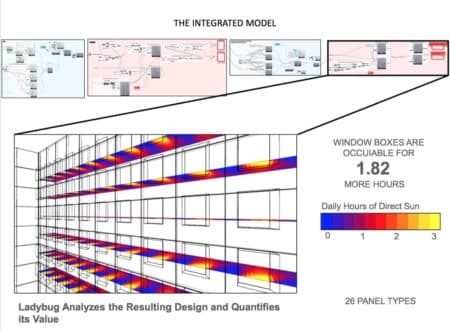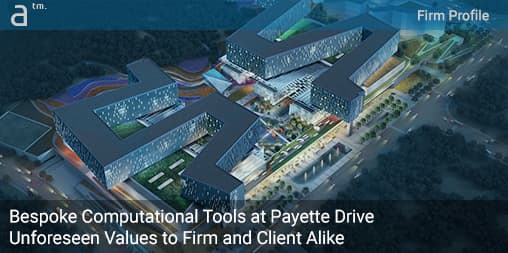Continued from page 1
Diffusing Computational Knowledge
Seeing Garay and Mackey’s bespoke digital tools put to work like this on real projects leads one to think of one obvious conclusion: Payette has an edge with these tools and the skill sets to drive them.
So it is somewhat shocking to learn that Payette is sharing its digital tools with the world. Garay explains that SkinDesigner, his tool, is being open-sourced and shared just like the other tools in the Grasshopper universe (e.g., Ladybug, Honeybee, HumanUI). I asked both of them to explain the ultimate benefits of sharing their bespoke tools work with the world.

05 – Here we can see a segment of the whole process showing the control of direct sun and maximizing occupant comfort. (image: Payette / Architosh. All rights reserved)
“There are many benefits,” says Mackay. “the first one being that our tools become better when we get feedback from our peers not just internally here at Payette but also externally with the computational design community.” Mackey also explained that he has personally seen or heard of great tools being developed by individuals in firms that are not shared and then that person leaves a firm and that tool goes with them. “This is probably not the corporate answer you were expecting to hear,” adds Garay. “The tools simply get better from the feedback and so the community is vital to improving the development of the tool itself.”
Essentially Garay and Mackey are arguing the benefits of open-source software development put into the context of architectural practice. That’s great for the tools themselves, but there are more benefits to Payette as well. Mackey adds the point that if they don’t develop and release these tools then probably at some point someone else will do exactly that and they will get the leadership credit for doing it. It is better therefore for the firm to lead the way in tool development than to highlight their uniqueness in having them. “A client isn’t going to hire an architect because they have a certain tool,” adds Mackey, “a client cares about your design team and your reputation, they are hiring the people not hiring your tools.”
This is probably not the corporate answer you were expecting to hear. The tools simply get better from the feedback and so the community is vital to improving the tools development itself.
Garay adds that “you could market the uniqueness of your firm’s tools for a while but at some point, others will have tools just like them or even better if open-sourced.” In other words, you can be overtaken but the market can’t strip you of your leadership in open source tools and that is something a firm like Payette can leverage for a much longer time.

06 – Angle decisions are finalized after analyzing optimal conditions across an array of metrics. (image: Payette / Architosh. All rights reserved)
With Payette’s firm leadership gaining concrete use-cases, like the Fifth XiangYa Hospital, and a deeper understanding of the multiple benefits of computational design, Santiago Garay’s role has evolved. As Head of Design Technology Innovation at Payette, the goal is to disseminate and spread the use of computational design techniques and tools to the firm’s architects and designers. “We have goals to integrate our bespoke tools with a lot of our production tools, integrating Grasshopper and Dynamo with Revit,” says Garay. “Even some of our structural engineers have Grasshopper savviness, like SGH in Boston.” Garay adds one final point of interest, “even many of the recent grads joining the firm in the past few years have some Grasshopper knowledge,” he adds.
Closing Thoughts
Going forward Santiago Garay and Chris Mackey are enthusiastic about the computational tools directions and opportunities at Payette. “The firm looks at your history, and your skills,” adds Garay, “and if you have done good things they will give you some room, some space to flourish.”
Both Garay and Mackey know that computational design is a young new discipline in practice and its ultimate integration will take time. “What we are asking leadership now,” adds Mackey, “is to be able to bring us into the transitions between phases, because that is typically where we see opportunities.”
Image Credits
Format equates to “party with copyright” / “party with reserved rights of use.” (eg: image: Payette / Architosh. All rights reserved.)
Title image credit: Payette / Architosh. All rights reserved.




Reader Comments
Comments for this story are closed